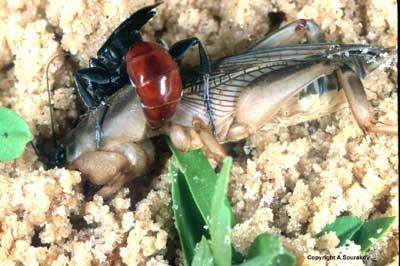|
Neoscapteriscus abbreviatus (Scudder)
(Ney-oh-scap-terr-ISK-us abb-reh-vee-AHT-us)
|
Distribution
The shortwinged mole cricket arrived in Florida and Georgia, from southern South America, about 1900 (but did not spread north and west of these states) and in Puerto Rico before 1917. Currently, it is found in Florida, Puerto Rico, and St. Croix in the Virgin Islands. It has not been seen in Georgia for years. The spread of shortwinged mole cricket populations inland has been very slight. All adults of this species seem to have short wings, rendering them incapable of flight (and, of course, incapable of flying to incandescent or fluorescent light). This most likely is the reason that they have colonized very little of the southeastern United States. After having arrived at ports, they still are restricted to coastal areas because they have not been able to disperse inland by flight.
Description
The shortwinged mole cricket typically appears to have a bulging abdomen. Its wings are very short (much shorter than the abdomen) and it cannot fly — do not confuse it with the large nymphs of other mole cricket species. The adults of the other four Neoscapteriscus species have long wings. The tibial dactyls of the shortwinged mole cricket are widely separated. It is of pale color and has small ocelli. The shortwinged mole cricket does not sing.
The color pattern of the dorsal side of the thorax is helpful in distinguishing between Neoscapteriscus species. The pronotum in this species is more elongated than in other species of Neoscapteriscus, and has a distinctive mottled color pattern.
|
The space between the tibial dactyls is important, but cannot be seen without a magnifying lens or microscope. The tibial dactyls of the shortwinged mole cricket have an interdactyl distance of 0.6 mm, and the dactyls are divergent.
|
The general appearance of the various species distinguishes them when they are compared or when the observer is familiar with them, but is difficult to put into a short but easily-understood written description. The behavior of living adults of the species helps to distinguish them when they are captured alive. The songs of males of the four species that sing separate them very clearly and without question, but require electronic equipment for precise analysis. The songs can be heard, remembered, and distinguished by anyone with a musical ear.
Life Cycle
The seasonality of the shortwinged mole cricket is poorly understood. All developmental stages seem to occur at all seasons of the year, but there is a peak of oviposition in late spring or summer and a lesser peak in winter. Females in captivity will oviposit throughout the year, unlike tawny and southern mole crickets, so the shortwinged mole cricket is a good laboratory animal for experimentation.
Life cycles of this and other species are contrasted in this knowledgebase with that of the tawny mole cricket, because it is the best-studied species.
Damage
The shortwinged mole cricket is a pest of vegetable seedlings and turf. The shortwinged mole cricket feeds largely on plant material, and only to a slight extent on insects and other animals. They feed on plant roots, stems, and leaves in much the same way as does the tawny mole cricket. Where they are the dominant species, for example in coastal areas of southeastern Florida, they are the major pest among the mole crickets.
Steinernema scapterisci Nguyen & Smart is a species of steinernematid nematode native to South America. Living specimens were obtained in Uruguay in 1985 and brought to Gainesville for testing by members of the UF/IFAS mole cricket program. Initial tests showed that S. scapterisci killed only about 75% of shortwinged mole crickets exposed to it. It does seem, from results of initial tests and of later tests, that shortwinged mole crickets are less susceptible to this nematode than are tawny and southern mole crickets.
Larra bicolor, a species of crabronid wasps, was introduced to Puerto Rico in the 1930s to combat Neoscapteriscus didactylus (Latreille). A laboratory study published in 1984 showed, however, that this species of mole cricket is not dealt with very successfully by the wasp. A better host is the shortwinged mole cricket, which has inhabited Puerto Rico since at least the early 20th century.
The behavior of Larra bicolor was studied in the field at Ft. Lauderdale in the mid-1980s. There, wasp eggs and larvae were not found on tawny and southern mole crickets, even though those mole crickets were attacked by the wasp in the laboratory. Instead, wasp eggs and larvae were only found on shortwinged mole crickets. It is curious that shortwinged mole crickets are the only species shared between Florida and Puerto Rico. There is thus a possibility that it is the shortwinged mole cricket that serves as the major host of the wasp in Puerto Rico, too.
However, the discovery in 1993 that a Bolivian stock of Larra bicolor was established in Alachua county, where the only Neoscapteriscus mole crickets are the southern and tawny mole crickets, demonstrates that these do serve as hosts.
 |
The shortwinged mole cricket is not very susceptible to Ormia depleta (the red-eyed fly) because, being wingless, it does not sing and does not advertise its presence. It seems likely that Ormia depleta could discover shortwinged mole crickets only if they were adjacent to singing males of tawny or southern mole crickets.